In this article, I will discuss Advanced Price Action Analysis in Trading. This is a continuation of our previous article, so please read it before proceeding to this one. In that article, we discussed the basic concept of Price Action Analysis in Trading. As part of this article, I will discuss the following pointers in detail.
- What are high and low?
- What is the swing high and swing low?
- Criteria for drawing swing high and swing low
- Types of swing high
- Strength and Weakness of Trend through Analysis Swing.
Before going forward, let me know if this is the extension part of the price action analysis. so I would suggest going through the previous article
Let’s begin
Understanding Market Structure through the swing
It is similar to learning to read a new alphabet- once you understand the characters, you can read the words, and once you know the words, you can read the story. The first letter to the master tells you what market activity causes the formation of a short-term high or low. If you learn this basic point, the meaning of all market structures will begin to fall into place.
The market moves in the up-down wave, what we call a market swing. In a healthy bull trend, the upswing generally exceeds the downswing in length. The reverse is true for the bear market. Hence, by observing market swing, we can glimpse the market structure and get clues on whether the market will increase or decrease.
Swing high and swing low.
Criteria for drawing swing high and swing low
SWING HIGH OR SWING LOW CONSIST OF MINIMUM 5 BAR. The middle bar must be higher and lower than the two proceeding bars and the two following bars.
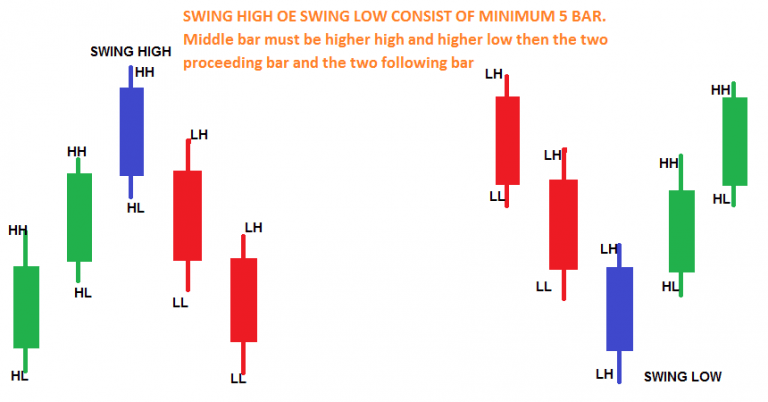
Restriction for drawing swing high and swing low
- If the bar high is parallel to the middle or high(LOW) bar, it does not count as one of the five bars in the swing HIGH (LOW) because it does not have a lower high(HIGHER LOW) than the middle bar.
- TWO ADJACENT swings high or swing low may share bars
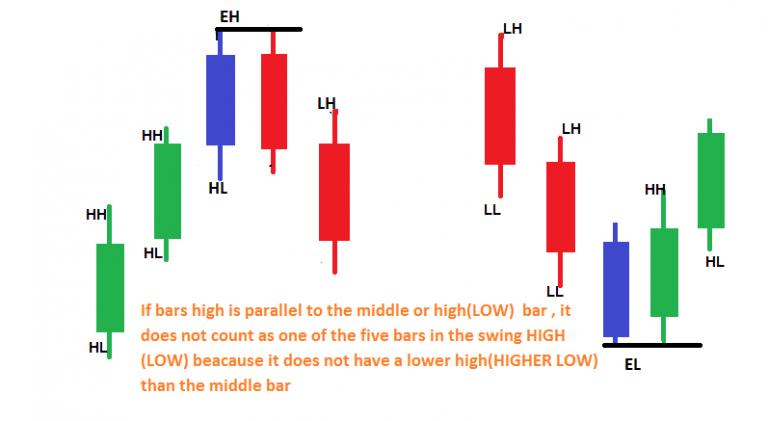

- A swing high
- B both swing high and swing low. This happens because two proceeding bars and two following bars are inside bars, which fulfills the requirement that the middle bar must be the highest or lowest point of the bar sequence.
- C both up and downswing by sharing bar
- D requires six bars to form a swing high, as the fifth bar equals the middle bar.
Why important?
These points are not random, and the market creates them. they represent momentary changes and demand and supply forces. The bulls could not move the market above the swing high. This means that at that point in time, no one was willing to offer a price higher than the swing high. Traders saw no value above the swing high
In a nutshell, there are two key skills in reading price action:
- Evaluate how likely a swing pivot will hold up as support/resistance
- Understand the implication of a swing pivot not holding up as support/resistance
Swing types
There are two types of swing
- High and low
- Swing high and swing low
Let me explain to you
Swing low(SL)
The market tried to move down. Then, it stopped, and the bullish trend resumed. The market broke all resistance(swing high) and made a new trend high. In other words, the market failed terribly to move down. The lowest point it pushed to is called swing low.

Tip: A valid pivot makes sense only within the trending price action. To find a valid low, you need to know the start point of the trend and the last extreme trend high. Then what about point B? Point B is called a LOW, not a swing low
Swing low
Every major market has some shallow pullback, and some last for one swing. The point where pullback goes deeper and lasts for more than one swing, forming a LOW. Eventually, this deeper pullback terminated, and the trend resumed. A low becomes a swing low once the price breaks out above the last extreme price high for the resumption of the bullish trend. Let me explain to you.


All the concepts discussed above are applicable for a swing high and high
HOW TO KNOW WHEN LOW BECOMES SWING LOW
When the price cleared, the above swing to a high level. The market must form a price bar completely above the price level to clear a price level. This means if a bar low is higher than a price level, the market has cleared above the price level.
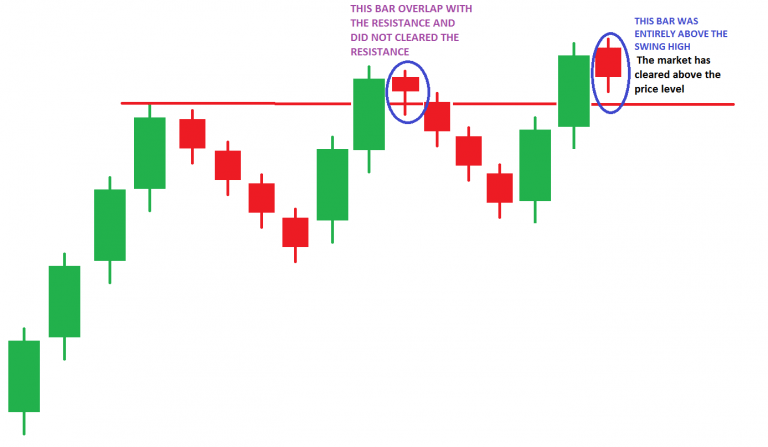
UNDERSTANDING MARKET SWINGS in Advanced Candlestick Analysis
We have understood how to find out swing high and swing low
Let’s understand strengths and weaknesses or trends through an ANALYSIS OF swing
- Momentum
- Thrust and pullback
- Volume
What is Momentum?
The rate at which price moves with respect to time
We are observing price action to compare price movement’s current speed and acceleration with historical speed and acceleration. Momentum is visible on a chart when the slope (angle) of price movement is observed.

The same concept applies to price action on charts. Changes in momentum are observed through changes in the slope (angle) of the price action.
Analysis of momentum is not about measuring its absolute value but about comparing current price action momentum with prior price action momentum.
We can compare through.
- Candle
- Swing
Momentum through candle
Compare the current candle’s momentum with the previous candle’s momentum.

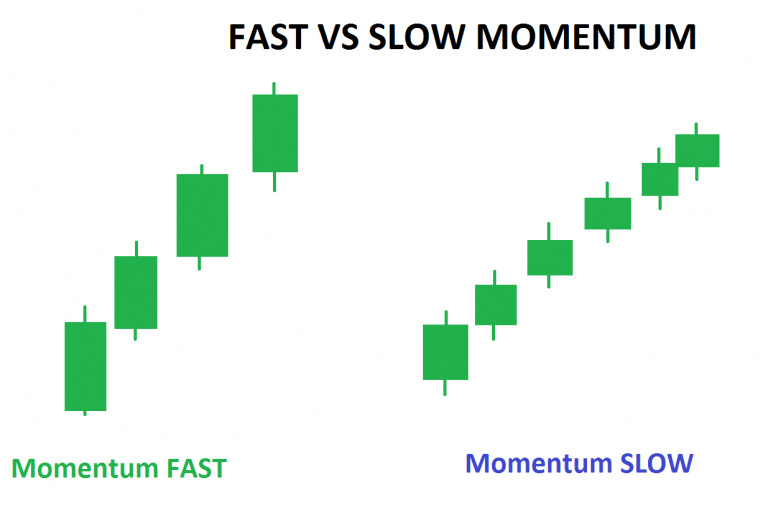
BAR COUNTING
- Counting the number of bars in a half cycle and comparing one-half cycle to another (previous half cycle)
- Comparing each swing(relative strength of move)
- How much time to get up or how much time to get down

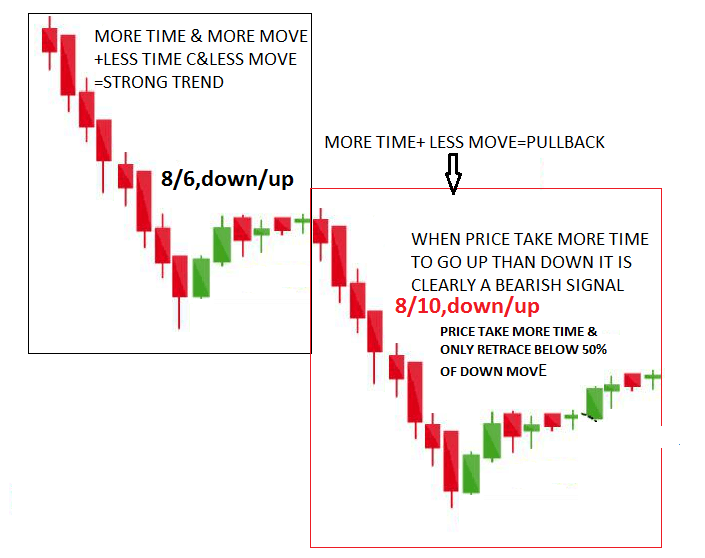

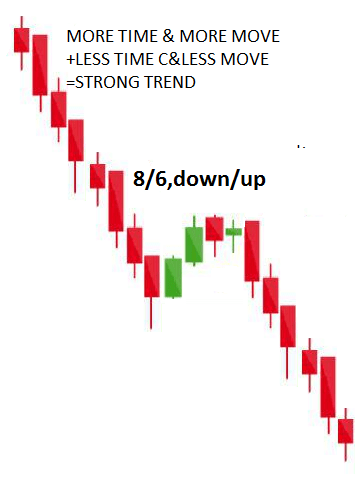

Momentum through swing
- Compare the momentum of the current price swing with the momentum of the previous price swing in the same direction.
- Compare the momentum of the current price swing with the momentum of the previous price swing in the opposite direction.
- Is the current price accelerating or decelerating? What does that mean?
1) Compare the momentum of the current price swing with the momentum of the previous price swing in the same direction.

Now, let’s remove the downswing and study what it shows. Is the price faster or slower than before?
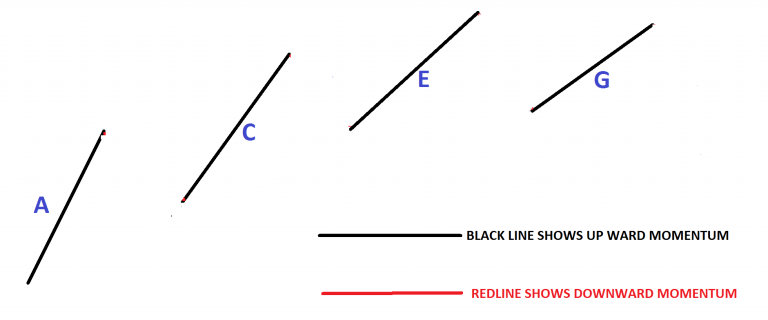
Compare the slope of UP-swings (a), (c), (e), and (g). Note the decreased speed on each of these legs, indicating a reduction in bullish momentum. Weakness is appearing on the bullish side.
Clearly shows upward momentum decreasing.
Now, putting the same chart with only downward momentum

Compare the slope of upswings (B), (D), (F), and (H). Note the increasing speed on each leg, indicating an increase in bearish momentum. bearish price swings are showing signs of strength.
COMPARING THE SWING indicates an increase in bearish momentum. Bearish price swings are showing signs of strength. The price movement is more likely to continue in the direction of strength and against the direction of weakness.

2) Compare the momentum of the current price swing with the momentum of the previous price swing in the opposite direction.

That is, comparing the current bullish swing with the previous bearish swing or the current bearish swing with the previous bullish swing. Note the slope of (a) is quite steep compared with the slope of (b). The latest upswing (b) has shown weakness compared with the previous downswing (a). Strength is still in the bearish direction.
The bullish upswing (d) shows an increase in speed compared with the last downswing (c). At the same time, the strength is now on the bullish side. The shallow angle of downward momentum compared with the steep rise of upward momentum indicates that Strength is now clearly on the bullish side.
The price movement is expected in the direction of strength and against the direction of weakness.

3) Is the current price accelerating or decelerating? What does that mean?



The deceleration in this example is evidence of bullish momentum gradually weakening as bearish pressure overcomes any bullish pressure.

